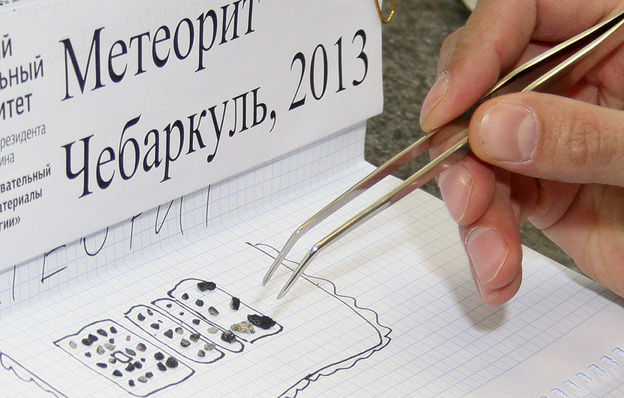by BILL CHAPPELL | February 22, 2013 | the two-way BREAKING NEWS FROM NPR
Alexander Khlopotov/AP

The meteor that caused at least 1,000 injuries in Russia after a startling and powerful daytime explosion one week ago has been identified as a chondrite. Russian scientists who analyzed fragments of the meteor, whose large size and well-documented impact made it a rarity, say that its composition makes it the most common type of meteor we encounter here on Earth.
“The fragments contain a standard number of minerals, including olivine, pyroxene, troilite and kamacite,” scientist Viktor Grokhovsky of the Urals Federal University, told the Voice of Russia. “These minerals that can be discovered only in outer space confirm the fragments’ extraterrestrial nature.”
That means that before it shattered windows in the city of Chelyabinsk and turned people around the world into gawkers fascinated by a calamity — and by the amazing video footage of it — the meteor spent billions of years traveling through space.
When it detonated over Russia, the explosion was powerful enough to be “detected by 17 nuclear monitoring stations around the globe,” as The Christian Science Monitor reports.
The meteor, which may have weighed as much as 10,000 tons and measured about 55 feet across, was traveling at an estimated 11 miles per second when it reached Earth, according to a report at io9.
“Chondrites are some of the most primitive rocks in the solar system,” says Britain’s Natural History Museum. “These 4.5-billion-year-old meteorites have not changed much from the asteroid they came from.”
The museum says the meteor’s name — pronounced with a hard “K” sound — comes from the Greek word for grains of sand.
But in the region where the meteor fell, the chondrite goes by another title: a chance to cash in. As NPR’s David Greene tells Linda Wertheimer on Morning Edition, people have been scrambling to collect pieces of the famous meteor.
“A 16-year-old pulled one out of his pocket and said, ‘Here’s a piece of the meteor, right here,” David says. “And this black market is developing. People have been coming to these villages and offering $100, $200 for little handfuls of space debris. The government’s worried that people are going to be trying to sell it fraudulently. So, this whole new economic reality is developing around this stuff.”



